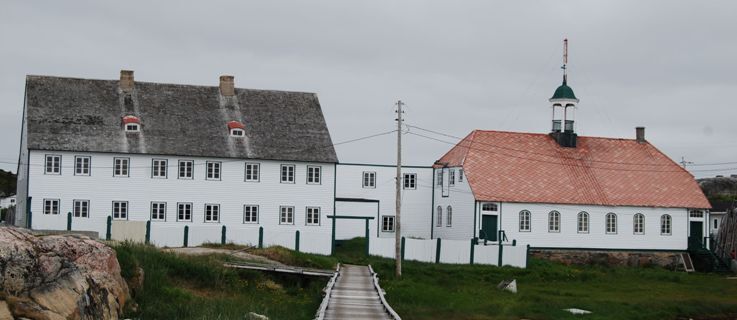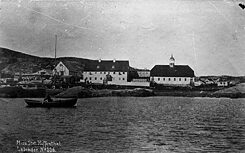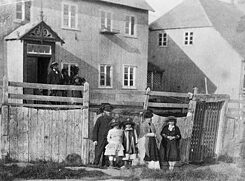German Traces in Newfoundland
German Missionaries in Newfoundland

During the 18th century, German missionaries have been active in many parts of the world. This includes Labrador, Canada. The first mission of the Protestant “Herrnhuter Brethren” was shattered in 1752 in Hopedale when angry Inuit destroyed the mission house. Due to the negative experiences with the often violent European traders and fishermen, the Inuit had been rather suspicious of the Herrnhuter.
 A historical photograph of the mission building
| © Them Days Inc.
Only in 1771 the Dane Jens Haven permanently established a mission station in Labrador. In the town of Makkovik, missionaries of the Herrnhuter Brethren founded a first mission house, which they called "Hoffnungsthal". It was destroyed by a fire in 1921. The present church was built in 1992.
A historical photograph of the mission building
| © Them Days Inc.
Only in 1771 the Dane Jens Haven permanently established a mission station in Labrador. In the town of Makkovik, missionaries of the Herrnhuter Brethren founded a first mission house, which they called "Hoffnungsthal". It was destroyed by a fire in 1921. The present church was built in 1992.
In the center of the community was a mission house with living spaces and common areas, as well as a shop where German-style products of all sorts could be bought. Until today, some baroque style facades can still be seen. Parts for the mission houses and churches were shipped from Germany to Canada. Especially popular in the parish houses of the Herrnhuter were the German tiled stoves.
 Missionaries in front of the mission house in Hopedale, August 1886
| © Library and Archives Canada / PA-139011
After initial difficulties, the missionaries worked peacefully with the Inuit. Schools were set up in which the students were taught Inuktitut. A new writing system was then established for this language. In 1864 Friedrich Erdmann published the first dictionary on Inuktitut and German. Based on aspects of German culture and European realities, missionaries brought new ideas and European legal and social systems to remote areas of Labrador. Unfortunately, an important part of the culture and way of life of the Inuit was irrevocably lost. Through the mission of the Herrnhuter Brethren in Labrador, a cultural contact took place that lives to this day. Advent wreaths, decorated fir-trees and German hymns in Inuktitut are still to be found in remote places of Labrador around Christmas time.
Missionaries in front of the mission house in Hopedale, August 1886
| © Library and Archives Canada / PA-139011
After initial difficulties, the missionaries worked peacefully with the Inuit. Schools were set up in which the students were taught Inuktitut. A new writing system was then established for this language. In 1864 Friedrich Erdmann published the first dictionary on Inuktitut and German. Based on aspects of German culture and European realities, missionaries brought new ideas and European legal and social systems to remote areas of Labrador. Unfortunately, an important part of the culture and way of life of the Inuit was irrevocably lost. Through the mission of the Herrnhuter Brethren in Labrador, a cultural contact took place that lives to this day. Advent wreaths, decorated fir-trees and German hymns in Inuktitut are still to be found in remote places of Labrador around Christmas time.
Against the advice of the missionaries, on August 25, 1880, eight Inuit from the Hebron and Nachvak region were recruited by Carl Hagenbeck, a German exotic-animal merchant who specialized in "ethnographic spectacles". They were embarked on the sailing ship “Eisbär” with dogs and kayaks. Weakened by disease, the Inuit experienced a tragic destiny in this human zoo. For one year they were led from Hamburg to Berlin across Germany and were supposed to imitate hunting scenes. They never saw their homeland again.
Source: “Bassler, Gerhard, “The Esquimaux … cannot be in better hands.” in: Bassler: Vikings to U-Boats: the German experience in Newfoundland and Labrador. McGill-Queen's Press-MQUP, 2014, 29-61)
Hopedale Mission Natural Historic Site
Government Rd
Hopedale, NL A0P 1G0
Comments
Comment